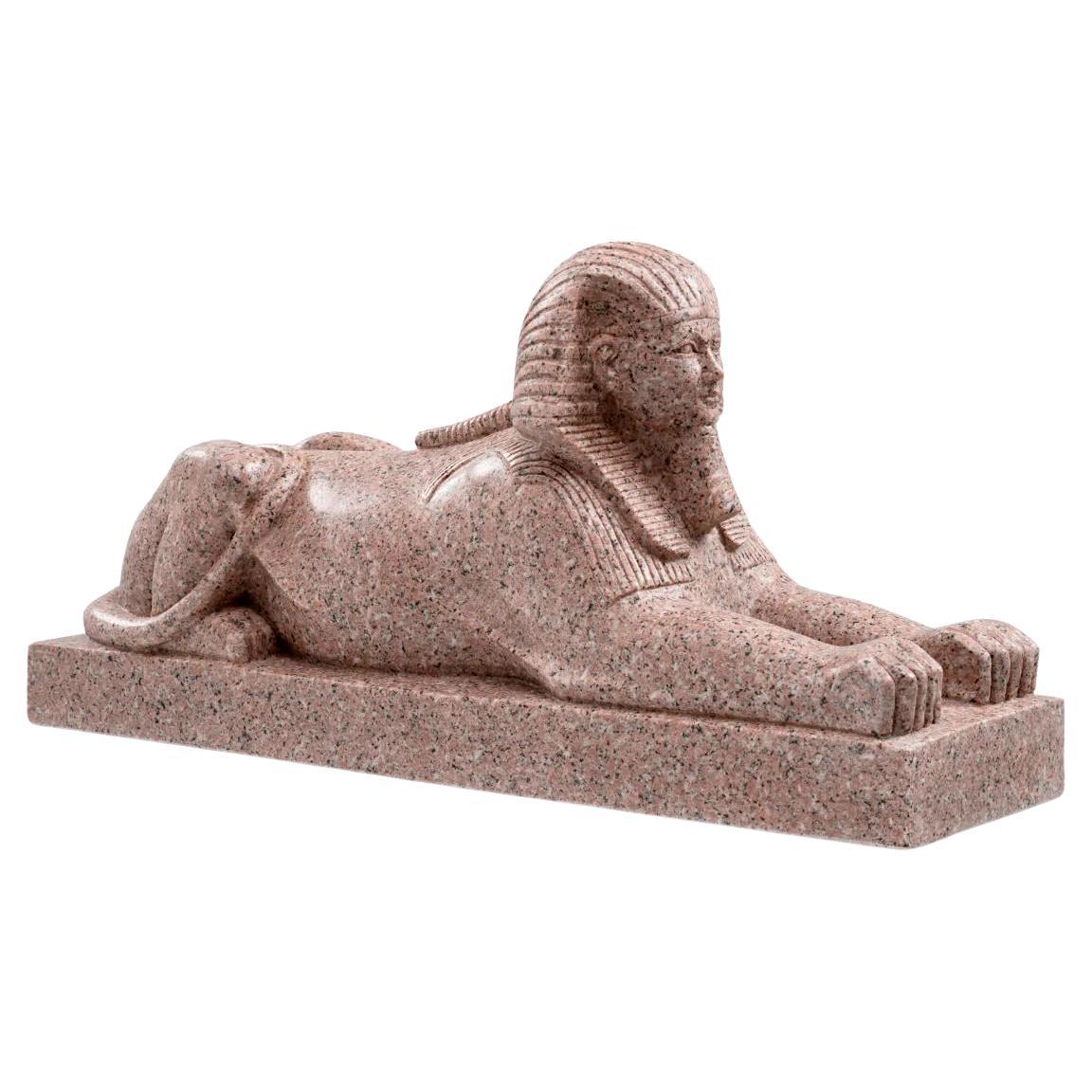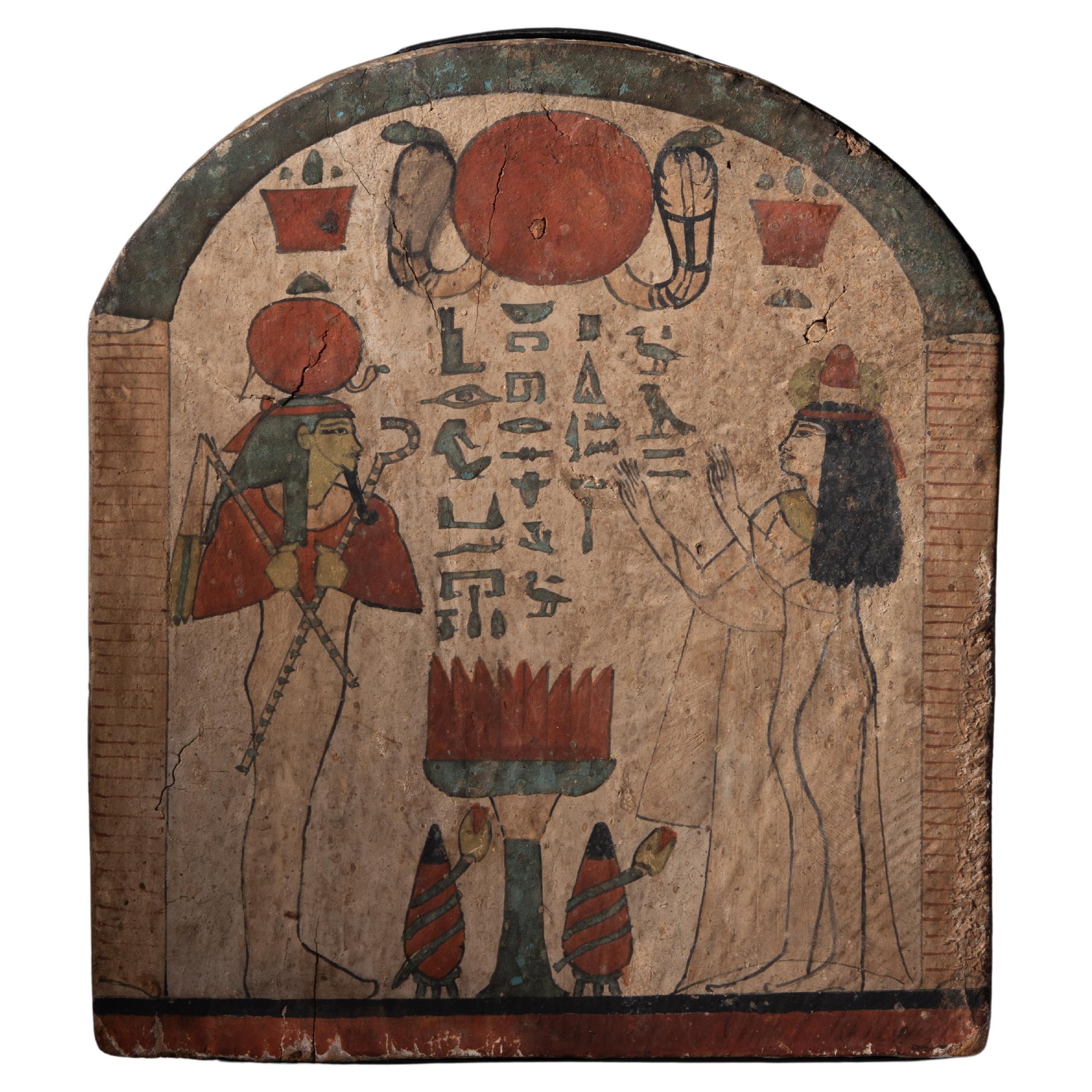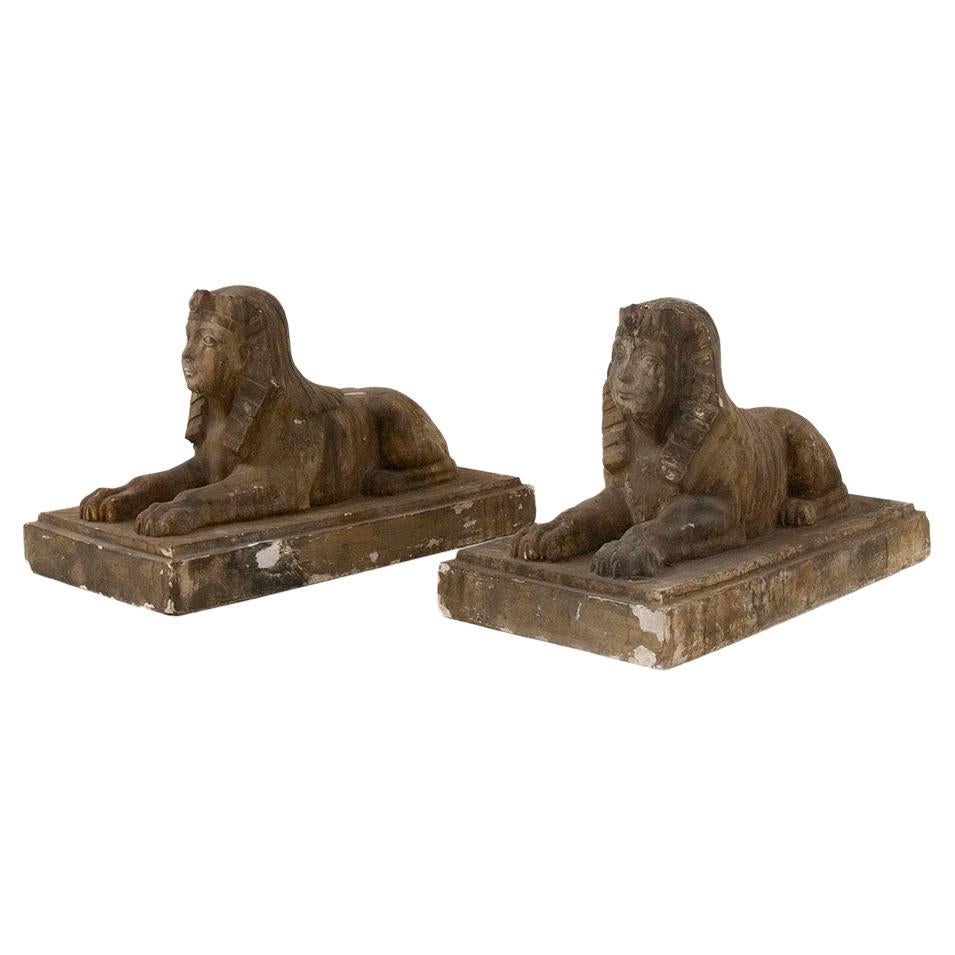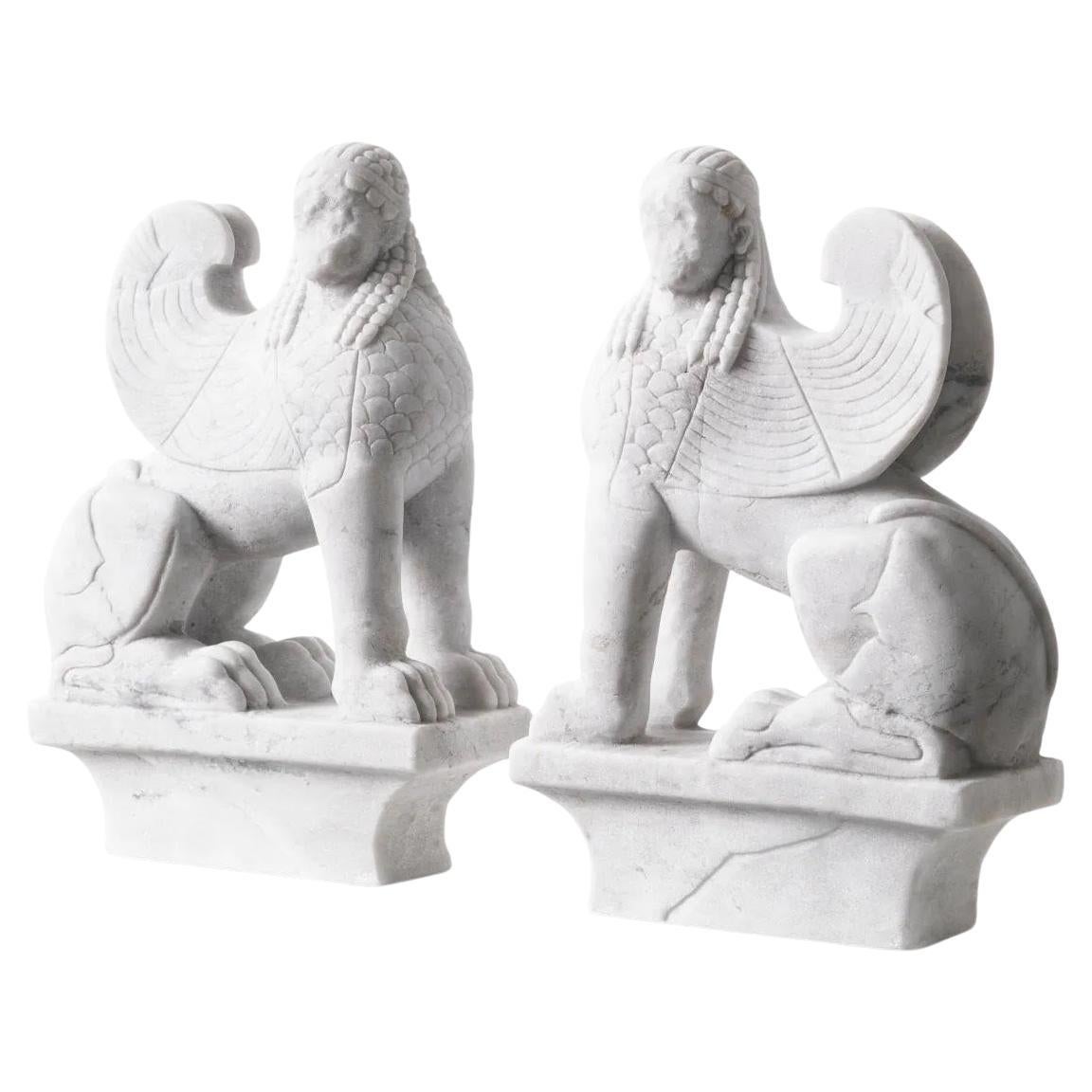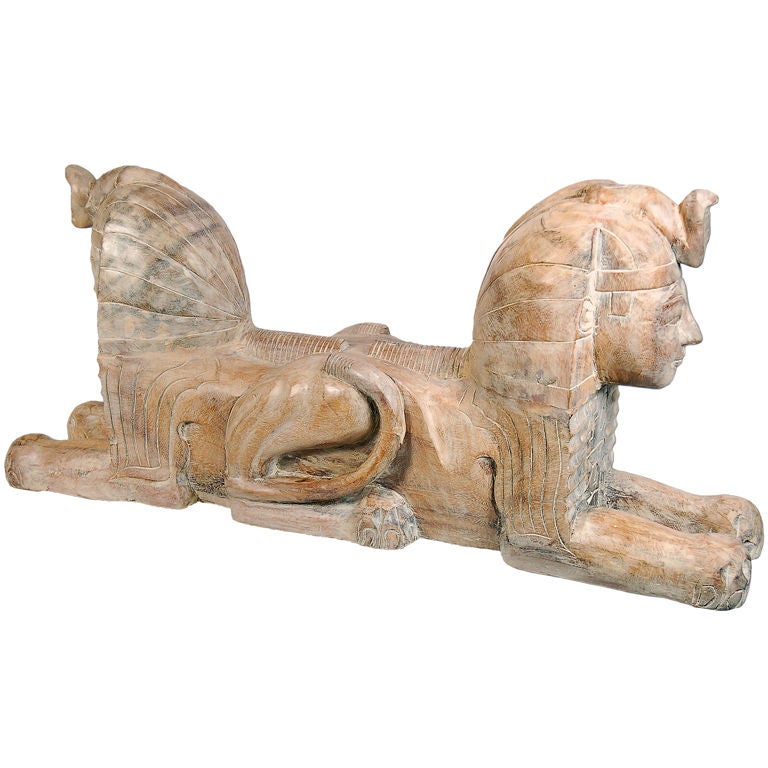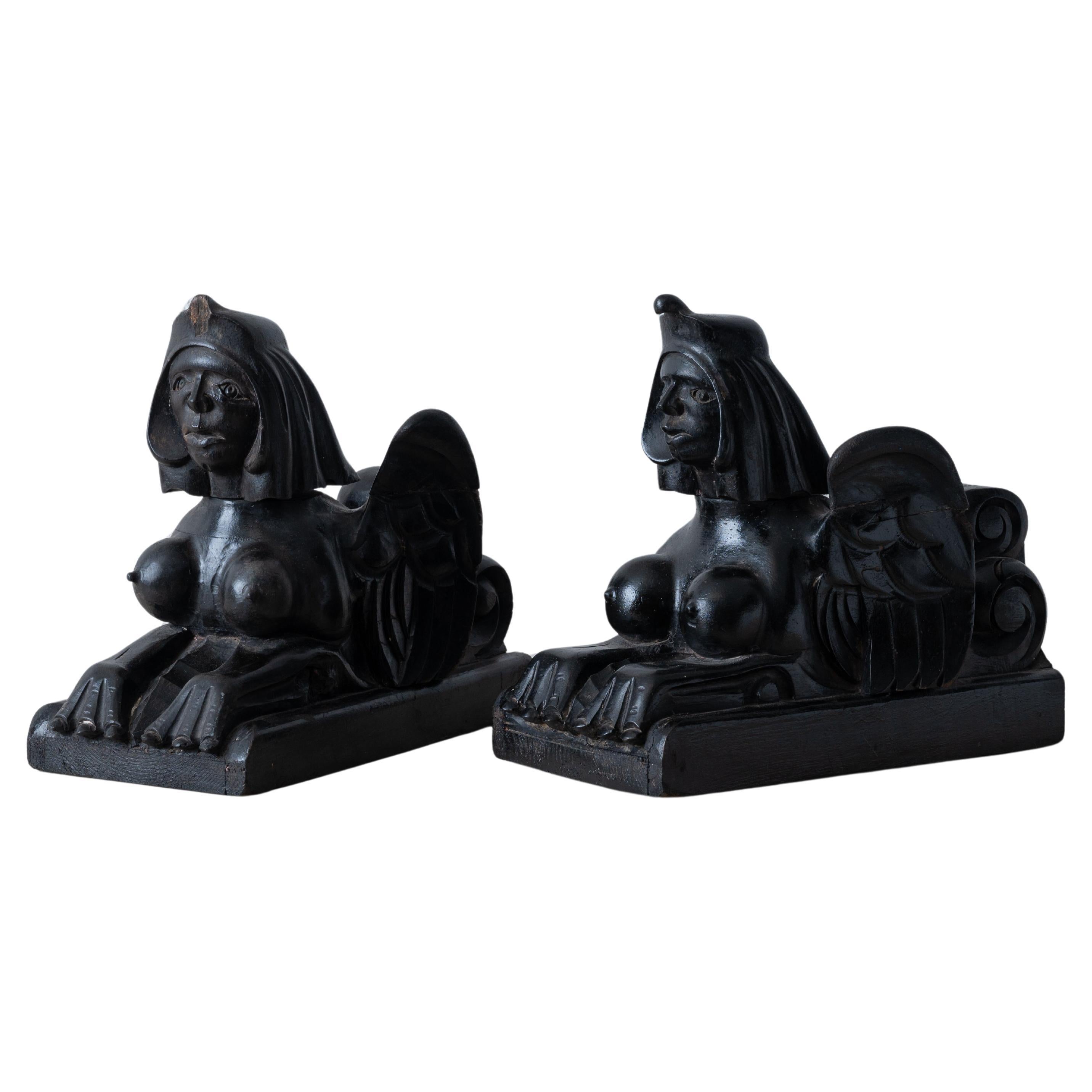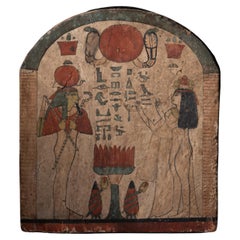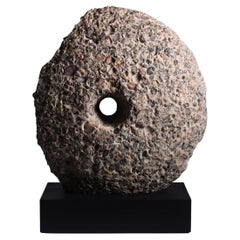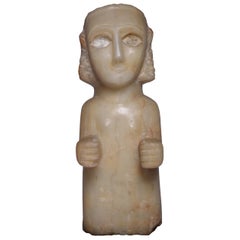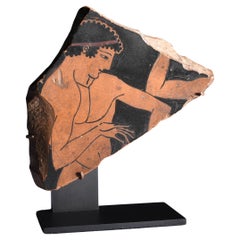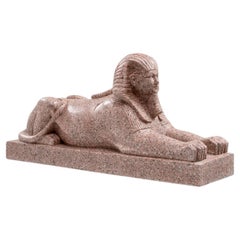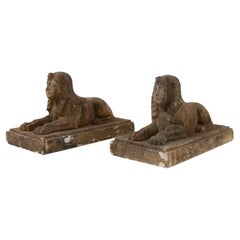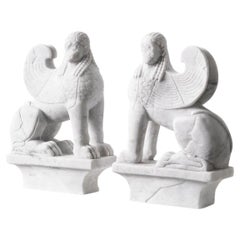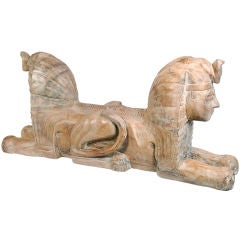Items Similar to Ancient Egyptian Monumental Temple Sphinxes
Want more images or videos?
Request additional images or videos from the seller
1 of 6
Ancient Egyptian Monumental Temple Sphinxes
About the Item
A pair of monumental limestone sphinxes of Pharaoh Nectanebo I, from the processional avenue of the Serapeum of Memphis, 30th Dynasty, circa 379 - 360 BC.
The sphinxes of the Serapeum have captivated travellers since Roman times. However, despite their significance, they are conspicuously absent from the collections of most major museums. Indeed, their existence in private hands is so improbable, and their imitations so numerous, that the present sphinxes were assumed to be modern copies throughout their recent ownership history. Finally recognised and conserved after an extraordinary chance discovery at a garden furniture sale, they are now reattributed as lost Egyptian masterworks from one of Egypt’s most important sites.
A quintessentially Egyptian symbol, the sphinx has fascinated beholders for millennia. This enigmatic hybrid creature is perhaps best known from the Great Sphinx of Giza, built under pharaoh Khafre during the 4th Dynasty (c.2613 - 2494 B.C.) and which has since become a national emblem of Egypt. In antiquity, sphinxes were ubiquitous figures of Egyptian religious life. The lion, symbolising divine force, combined with the head of the pharaoh, alluding to the invincible strength of the king. Sphinxes were strongly associated with Horus, the god of the sky, of whom the pharaoh was thought to be a manifestation during his life. The sphinx was therefore a strong protective figure whose representations frequently served as guardians of sacred places.
Nectanebo I (c.379-360 B.C.) became Pharaoh during a time of political uncertainty, marked by an increasing foreign presence and incursions led by the Persians, who had previously ruled the country between 525 and 404 B.C. As a skilled army general, Nectanebo successfully repelled these attacks and established a period of peace and prosperity in Egypt. To cement his reputation as the defender of Egyptian traditions, the pharaoh patronised a rich artistic production and strengthened religious institutions. His reign is marked by his ambitious architectural projects, such as the magnificent temple of Isis at Philae and the great sphinx alley leading to the Serapeum of Memphis.
The Serapeum, located at Saqqara, the necropolis of the city of Memphis, was a giant complex of subterranean galleries which served as the burial chambers for the sacred Apis bulls. Only one bull was worshipped at a time and was kept in the temple of Ptah in Memphis. When it died, it was publicly mourned with a lavish ceremonial burial at the Serapeum. These burial rituals lasted for seventy days, culminating in a procession from the temple of Ptah to the Serapeum.
The Serapeum, which had been used as a burial place as early as 1400 B.C., was frequently enlarged and improved by the Egyptian kings over the centuries. During the Heb Sed festival, celebrated during his thirtieth year on the throne, the pharaoh would run a race alongside the Apis bull as part of a series of rituals meant to prove his fitness to rule and restore his powers. This festival was the most important royal celebration in ancient Egypt from the Early Dynastic through to the Ptolemaic Period. The king was also summoned to the temple of Ptah when the bull died, and participated
in the funerary procession, indicating the importance of the Apis bull in both religious and political life.
It is particularly noteworthy that all foreign dynasties in Egyptian history continued to donate generously to the Apis cult and improve the Serapeum in order to legitimise their rule, testifying to the utmost importance of the Serapeum to native Egyptians. The Apis cult was particularly popular during the Late Period. This might in part explain the importance of Nectanebo’s renovation project at the Serapeum, which included enlarging the temple and embellishing its gateway. The new processional alley, which was around 1120 metres long, was flanked by around 370 to 480 sphinxes. The sphinx alley occupied a crucial role in the cult of Apis, protecting the funerary procession bringing the sacred bull to its burial chamber.
The Serapeum was abandoned at the beginning of the Roman period, circa A.D. 30, and many of its monuments, including the sphinxes, were progressively covered by the desert sands. Forgotten for centuries, the story of their discovery in the 19th century is both complex and fascinating.
The Serapeum and its location in Memphis was known to early Egyptologists from the writings of ancient authors, such as Herodotus, Strabo, Pliny, and Plutarch, however it had long since been buried in the desert sands. Its rediscovery is generally attributed to French Egyptologist Auguste Mariette (1821-1881). A young, self-taught scholar, Mariette had been sent to Egypt by the Louvre in October 1850 to purchase Coptic, Syriac, Arabic and Ethiopian manuscripts. However, this mission quickly turned out to be a failure, and Mariette’s archaeological ambitions soon fixed upon a different objective: the Serapeum of Memphis. The quest to locate the Serapeum was largely inspired by the sphinxes he admired in the gardens of several prominent European men he visited in Alexandria and Cairo. Mariette was told that these sphinxes were sold by Solomon Fernandez, a Spanish-Jewish antiquities dealer who claimed to have discovered the Serapeum. Hungry for discovery, Mariette set out to find the ancient site.
At Saqqara, whilst trying to determine the plan of the tombs, Mariette came across a sphinx similar to those he had encountered in Cairo and Alexandria. According to the well-known legend – now part of Egyptological folklore – this reminded him of a quote by Strabo, which confirmed the importance of his discovery:
‘“One finds,” said the geographer Strabo (1st century AD), “a temple to Serapis in such a sandy place that the wind heaps up the sand dunes beneath which we saw sphinxes, some half buried, some buried up to the head, from which one can suppose that the way to this temple could not be without danger if one were caught in a sudden wind storm.” Did it not seem that Strabo had written this sentence to help us rediscover, after over eighteen centuries, the famous temple dedicated to Serapis? It was impossible to doubt it. This buried Sphinx, the companion of fifteen others I had encountered in Alexandria and Cairo, formed with them, according to the evidence, part of the avenue that led to the Memphis Serapeum...
It did not seem to me possible to leave to others the credit and profit of exploring this temple whose remains a fortunate chance had allowed me to discover and whose location henceforth would be known. Undoubtedly many precious fragments, many statues, many unknown texts were hidden beneath the sand upon which I stood. These considerations made all my scruples disappear. At that instant I forgot my mission (obtaining Cop-
tic texts from the monasteries), I forgot the Patriarch, the convents, the Coptic and Syriac manuscripts, Linant Bey himself, and it was thus, on 1 November 1850, during one of the most beautiful sunrises I had ever seen in Egypt, that a group of thirty workmen, working under my orders near that sphinx, were about to cause such total upheaval in the conditions of my stay in Egypt.’
The processional alley leading to the Serapeum has now been lost to the sands once again, and despite academic efforts throughout the twentieth century, it still needs to be fully explored. Full-size sphinxes from the Serapeum are seldom encountered outside of Egyptian museums. With the exception of the Louvre Museum in Paris, Kunsthistorisches Museum in Vienna, and the Berlin Staatliche Museen, they are not represented in any major national museum collection. Indeed, they are notably absent from the collections of the Metropolitan Museum of Art, the British Museum, and the Egyptian Museum of Turin.
Whilst the iconic Serapeum sphinxes are absent from many of the leading museum collections of Egyptian art in the West, the present pair reappeared in the most un- likely of circumstances. Mistaken for 19th century copies, they had been used as patio ornaments for decades, before being dispersed in a garden furniture sale in October 2021.
The two sphinxes are depicted conventionally, portraying the face of the Pharaoh Nectanebo I on a lion’s body. They are shown seated, the powerful musculature of the body is finely carved, with tails curled round their haunches and forepaws outstretched. Both wear the nemes, the traditional royal headdress of the Pharaoh. The remnants of the uraeus, a stylised cobra and symbol of sovereignty and divine authority in ancient Egypt, is visible on sphinx B (Fig. 9), while a hollow area where the uraeus would have once been located is visible on sphinx A. The two faces have been carved in an idealising but naturalistic style, typical of the period. They are broad and rounded, displaying a serene expression, the eyelids, noses, and gently smiling lips softly modelled in the limestone. The eyes have been deeply carved, especially around the canthi. The neck and jawline are soft and have a fleshy appearance.
Now rediscovered, fully researched and conserved, the sphinxes stand once again as icons of ancient Egyptian culture. Like the other sphinxes from this site displayed in the Louvre and Vienna, they bear the marks of graffiti left centuries after their creation by Greek and Roman travellers. Visited and venerated throughout the ages by subsequent Pharaohs, later rulers and explorers, the sphinxes of the Serapeum of Memphis remain some of Egypt’s most famous and iconic temple sculptures.
Sphinx A: 105 x 68 x 38 cm
Sphinx B: 102 x 68 x 38 cm
Provenance:
Recovered from the Serapeum of Memphis, c. 1830-1860
Subsequently 19th Century English private collection
Subsequently in the collection of South-African born interior designer Dudley Poplak
Offered for sale by Cheffins Auctioneers, Cambridge, circa 2004
Acquired from the above by the last owners, Sudbury, Suffolk
Subsequently with Mander Auctions, 25/10/2021, lot 345 [misdescribed as 19th century stone garden models]
- Dimensions:Height: 26.78 in (68 cm)Width: 14.97 in (38 cm)Depth: 41.34 in (105 cm)
- Style:Egyptian (Of the Period)
- Materials and Techniques:
- Place of Origin:
- Period:
- Date of Manufacture:Circa 379-360 BC
- Condition:Repaired: Upper back of right sphinx restored and head reattached.
- Seller Location:London, GB
- Reference Number:Seller: 428271stDibs: LU1052233025372
About the Seller
5.0
Recognized Seller
These prestigious sellers are industry leaders and represent the highest echelon for item quality and design.
Established in 2008
1stDibs seller since 2014
100 sales on 1stDibs
Typical response time: 2 hours
Associations
LAPADA - The Association of Arts & Antiques DealersInternational Confederation of Art and Antique Dealers' AssociationsThe British Antique Dealers' Association
- ShippingRetrieving quote...Shipping from: London, United Kingdom
- Return Policy
Authenticity Guarantee
In the unlikely event there’s an issue with an item’s authenticity, contact us within 1 year for a full refund. DetailsMoney-Back Guarantee
If your item is not as described, is damaged in transit, or does not arrive, contact us within 7 days for a full refund. Details24-Hour Cancellation
You have a 24-hour grace period in which to reconsider your purchase, with no questions asked.Vetted Professional Sellers
Our world-class sellers must adhere to strict standards for service and quality, maintaining the integrity of our listings.Price-Match Guarantee
If you find that a seller listed the same item for a lower price elsewhere, we’ll match it.Trusted Global Delivery
Our best-in-class carrier network provides specialized shipping options worldwide, including custom delivery.More From This Seller
View AllAncient Egyptian Stele of Heres
Located in London, GB
WOODEN STELE OF HERES-IB, DAUGHTER OF PADI-AMUN, SON OF HOR
Third Intermediate Period
Dynasty 22, ca. 945-900 BC.
Egypt, Thebes
25 x 22.5 x 2 cm
Without base: 15.3 cm
PROVENANCE
Co...
Category
Antique 15th Century and Earlier Egyptian Egyptian Mounted Objects
Materials
Wood
Ancient Gallo Roman Millstone
Located in London, GB
Gallo-Roman Quernstone
Fécamp, Seine-Maritime, France
Circa 2nd century BC - mid-4th century AD
Carved puddingstone
Diameter: 43 cm
The lower grinding stone from a late Iron Age, ea...
Category
Antique 15th Century and Earlier French Mounted Objects
Materials
Stone
Ancient South Arabian Alabaster Statue
Located in London, GB
South Arabian Calcite female figure
3rd Century BC to 1st century A.D.
Calcite Alabaster
height: 30.5 cm
A magnificent alabaster female figure, a f...
Category
Antique 15th Century and Earlier Yemeni Figurative Sculptures
Materials
Alabaster
Ancient Greek Red Figured Vase Fragment with an Athlete
Located in London, GB
An exquisite example of the artistic heights achieved by the most talented Greek painters of the Classical Period. A precious fragment from the centre of a wine cup, detailing a fine...
Category
Antique 15th Century and Earlier Mounted Objects
Materials
Pottery
Ancient Greek Perfume Bottle
Located in London, GB
Athenian Black-glaze perfume pot with inscription
Athens, c. 425-400 B.C.
Terracotta
Measures: Height: 9cm; diameter across lip: 7.5cm; width including handle: 9cm
This 5th Cen...
Category
Antique 15th Century and Earlier Italian Classical Greek Bottles
Materials
Pottery
Lunar Meteorite - A Piece of the Moon
Located in London, GB
A beautiful section of the lunar meteorite Gadamis 003, discovered in the oasis Berber town of Ghadames, Libya, and revealing a magnificent greyish-white spotted interior, evoking th...
Category
Antique 15th Century and Earlier Natural Specimens
Materials
Stone
You May Also Like
Granite Sculpture of a Sphinx in the Taste of Ancient Egypt.
Located in Saint-Ouen, FR
Granite sculpture of a Sphinx in the taste of ancient Egypt, 20th century.
Granite sculpture of a Sphinx in the taste of ancient Egypt, 20th century.
H: 28cm, W: 59cm, D: 16,5cm
Pr...
Category
21st Century and Contemporary French Egyptian Animal Sculptures
Materials
Granite
Pair of Egyptian sphinxes in gold-coloured scaiola plaster
Located in Milano, IT
Discover the epitome of elegance with this exquisite pair of Egyptian sphinx statues. Crafted with meticulous attention to detail, these magnificent sculptures are made of scaiola pl...
Category
Antique 1880s Italian Egyptian Animal Sculptures
Materials
Plaster
$5,576 Sale Price / set
20% Off
Sculpture of a Pair of Sphinxes in White Marble, Style of Ancient Egypt.
Located in Saint-Ouen, FR
Sculpture of a pair of Sphinxes in white marble, contemporary work in the taste of Ancient Egypt, XXIst century.
Sculpture of a pair of sphinxes in white marble, contemporary work i...
Category
21st Century and Contemporary French Modern Animal Sculptures
Materials
Marble
Two-Headed Egyptian Sphinx Sculpture
Located in Asheville, NC
This two-headed Egyptian sphinx is constructed of solid wood. The wood has been treated to take on a sandy, almost marble, finish. Unlike the Greek sph...
Category
20th Century Egyptian Sculptures
Materials
Wood
Egyptian Revival Sphinx Carvings, c.1880
Located in Savannah, GA
A pair of Egyptian Revival ebonized sphinx carvings, circa 1880.
6 ¼ inches wide by 12 inches deep by 10 inches tall
Category
Antique 1880s Egyptian Revival Figurative Sculptures
Materials
Wood
$1,200 / set
Egyptian Fragment of a Seated Man - Ancient Egypt, 26th Dynasty (664-525 BC)
Located in Bruxelles, BE
Egyptian Fragment of a Seated Man
Limestone - polychromy
Ancient Egypt, 26th Dynasty (664-525 BC)
Most likely from the tomb of Montw-m-H3t
Provenanc...
Category
Antique 15th Century and Earlier Egyptian Egyptian Figurative Sculptures
Materials
Limestone
